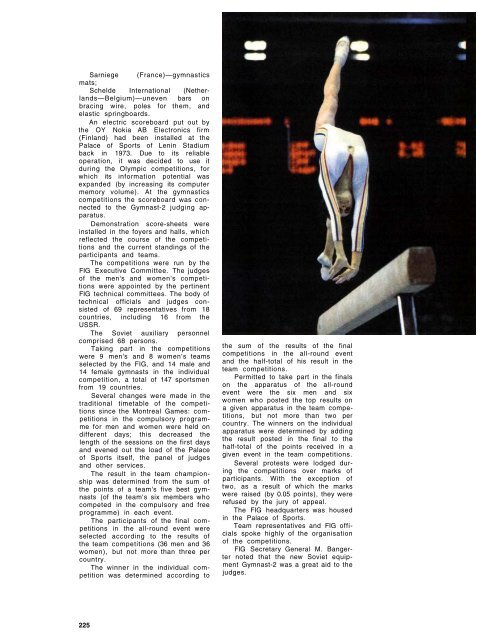or1980v2pt1
or1980v2pt1
or1980v2pt1
Create successful ePaper yourself
Turn your PDF publications into a flip-book with our unique Google optimized e-Paper software.
Sarniege (France)—gymnastics<br />
mats;<br />
Schelde International (Netherlands—Belgium)—uneven<br />
bars on<br />
bracing wire, poles for them, and<br />
elastic springboards.<br />
An electric scoreboard put out by<br />
the OY Nokia AB Electronics firm<br />
(Finland) had been installed at the<br />
Palace of Sports of Lenin Stadium<br />
back in 1973. Due to its reliable<br />
operation, it was decided to use it<br />
during the Olympic competitions, for<br />
which its information potential was<br />
expanded (by increasing its computer<br />
memory volume). At the gymnastics<br />
competitions the scoreboard was connected<br />
to the Gymnast-2 judging apparatus.<br />
Demonstration score-sheets were<br />
installed in the foyers and halls, which<br />
reflected the course of the competitions<br />
and the current standings of the<br />
participants and teams.<br />
The competitions were run by the<br />
FIG Executive Committee. The judges<br />
of the men's and women's competitions<br />
were appointed by the pertinent<br />
FIG technical committees. The body of<br />
technical officials and judges consisted<br />
of 69 representatives from 18<br />
countries, including 16 from the<br />
USSR.<br />
The Soviet auxiliary personnel<br />
comprised 68 persons.<br />
Taking part in the competitions<br />
were 9 men's and 8 women's teams<br />
selected by the FIG, and 14 male and<br />
14 female gymnasts in the individual<br />
competition, a total of 147 sportsmen<br />
from 19 countries.<br />
Several changes were made in the<br />
traditional timetable of the competitions<br />
since the Montreal Games: competitions<br />
in the compulsory programme<br />
for men and women were held on<br />
different days; this decreased the<br />
length of the sessions on the first days<br />
and evened out the load of the Palace<br />
of Sports itself, the panel of judges<br />
and other services.<br />
The result in the team championship<br />
was determined from the sum of<br />
the points of a team's five best gymnasts<br />
(of the team's six members who<br />
competed in the compulsory and free<br />
programme) in each event.<br />
The participants of the final competitions<br />
in the all-round event were<br />
selected according to the results of<br />
the team competitions (36 men and 36<br />
women), but not more than three per<br />
country.<br />
The winner in the individual competition<br />
was determined according to<br />
225<br />
the sum of the results of the final<br />
competitions in the all-round event<br />
and the half-total of his result in the<br />
team competitions.<br />
Permitted to take part in the finals<br />
on the apparatus of the all-round<br />
event were the six men and six<br />
women who posted the top results on<br />
a given apparatus in the team competitions,<br />
but not more than two per<br />
country. The winners on the individual<br />
apparatus were determined by adding<br />
the result posted in the final to the<br />
half-total of the points received in a<br />
given event in the team competitions.<br />
Several protests were lodged during<br />
the competitions over marks of<br />
participants. With the exception of<br />
two, as a result of which the marks<br />
were raised (by 0.05 points), they were<br />
refused by the jury of appeal.<br />
The FIG headquarters was housed<br />
in the Palace of Sports.<br />
Team representatives and FIG officials<br />
spoke highly of the organisation<br />
of the competitions.<br />
FIG Secretary General M. Bangerter<br />
noted that the new Soviet equipment<br />
Gymnast-2 was a great aid to the<br />
judges.


